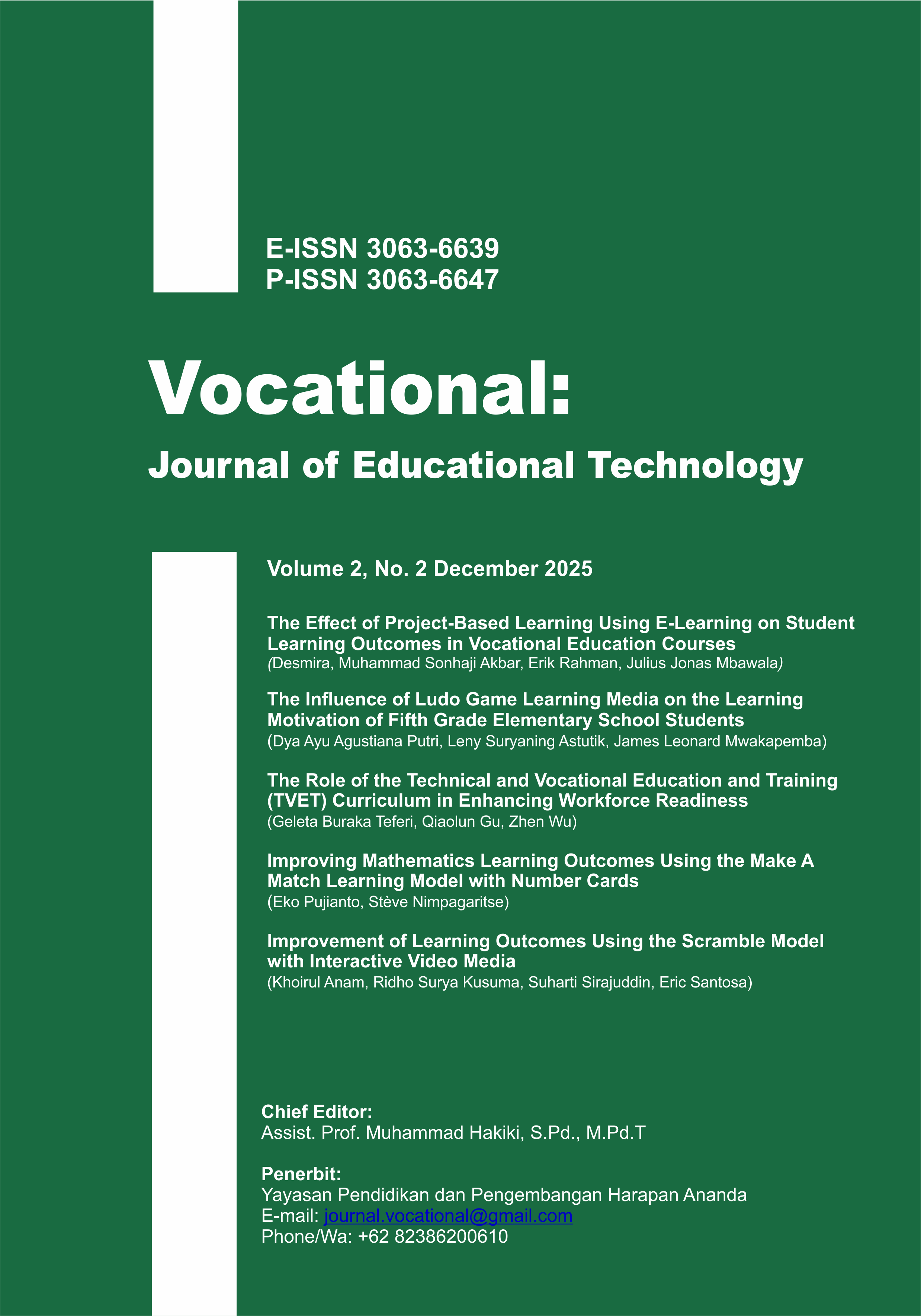Improving Mathematics Learning Outcomes Using the Make A Match Learning Model with Number Cards
DOI:
https://doi.org/10.58740/vocational.v2i2.610Keywords:
Mathematics Education, Make A Match, Number Cards, Classroom Action Research, Learning OutcomesAbstract
Mathematics remains one of the most challenging subjects for students, particularly in teacher education programs, where mastery is essential not only for academic success but also for future pedagogical practice. Conventional teacher-centered methods often fail to promote active engagement and deep conceptual understanding, underscoring the need for innovative approaches that combine interaction, collaboration, and enjoyable learning experiences. This study aimed to improve students’ mathematics learning outcomes through the implementation of the Make A Match learning model supported by number cards. The research employed a classroom action research design conducted in two cycles, each comprising the stages of planning, action, observation, and reflection. The participants were 28 undergraduate students enrolled in the Department of Primary School Teacher Education, Universitas Doktor Nugroho Magetan. Data were collected using formative tests, observation sheets, and field notes, and were analyzed through both quantitative and qualitative approaches. The findings demonstrated a consistent improvement in students’ learning outcomes. The mean score increased from 60.71 in the pre-cycle to 72.14 in Cycle I and 83.57 in Cycle II. Similarly, the percentage of students achieving mastery rose from 42.86% in the pre-cycle to 71.43% in Cycle I and 89.29% in Cycle II. Qualitative data supported these results, indicating enhanced engagement, collaboration, and active participation during learning activities. In conclusion, the Make A Match learning model with number cards effectively improved both the process and outcomes of mathematics learning. The study suggests that this strategy not only strengthens mathematical achievement but also fosters essential skills such as cooperation, communication, and problem-solving, making it a promising pedagogical approach for teacher education contexts.
References
Juliani, A., Mustadi, A., & Lisnawati, I. (2021). “Make A Match Model” for Improving the Understanding of Concepts and Student Learning Results. Indonesian Journal on Learning and Advanced Education (IJOLAE), 48-56. https://doi.org/10.23917/ijolae.v3i1.10269
Parahita, D. K., Faiziyah, N., Diana, Hadiarti, D., & Mukhlishin, H. (2024, January). The effect of the index card match method in mathematics learning on the students’ learning outcomes. In AIP Conference Proceedings (Vol. 2926, No. 1, p. 020023). AIP Publishing LLC. https://doi.org/10.1063/5.0183047
Susana, E. E. (2025). Improving Student Learning Outcomes Using the Index Card Match Method in Asmaul Husna Materials in Elementary School. Research Journal on Teacher Professional Development, 3(01), 37-45. https://journal.walisongo.ac.id/index.php/rjtpd/article/view/24938
Zainal, Z., Djabba, R., & Mukhallad, W. (2024). Implementation of the cooperative learning model of Index Card Match type to improve student learning outcomes. Jurnal Eduscience, 11(1), 1-10. https://doi.org/10.36987/jes.v11i1.3421
A. Solehah, Vera Mandailina, Mahsup, Abdillah, and Wasim Reza, “The Impact of Card-Based Learning Methods on Math Learning”, j. sains. teknologi., vol. 13, no. 1, pp. 67–81, Apr. 2024. https://doi.org/10.23887/jstundiksha.v13i1.65294
Aprilia, D., & Nugraheni, N. (2025). Development and Effectiveness of UN-MATH Cards in Enhancing Problem-Solving Skills for Elementary School Students. Jurnal Pendidikan Progresif, 15(1), 347-359. https://doi.org/10.23960/jpp.v15i1.pp347-359
Widja Hadi, “Use of the Make A Match Learning Model Against Elementary School Students’ Learning Outcomes”, Cendekiawan, vol. 3, no. 1, pp. 380–384, Apr. 2024. https://doi.org/10.61253/cendekiawan.v3i1.228
K. Widalaksita and F. Dwi Prasetyaningtyas, “Card Match Circle Learning Media to Improve Science and Social Learning Outcomes”, j. penelit. dan pengemb. pendidik., vol. 8, no. 3, pp. 547–556, Oct. 2024. https://doi.org/10.23887/jppp.v8i3.78923
P. Oktaria, C. Hiltrimartin, and L. S. J. Manulang, “APPLICATION OF MAKE A MATCH LEARNING MODEL TO IMPROVE MATHEMATICS LEARNING OUTCOMES IN CLASS VA OF STATE ELEMENTARY SCHOOL 1 PALEMBANG”, PROSPEK, vol. 6, no. 2, pp. 140–147, May 2025. https://doi.org/10.29303/prospek.v6i2.1281
H. Savitriana, Berta Apriza, and Darwanto, “The Effectiveness of Using the Make-A- Match Learning Model in Improving Mathematics Learning Outcomes in Elementary Schools: A Systematic Literature Review”, mimb.pgsd undiksha, vol. 13, no. 1, pp. 64–76, Apr. 2025. https://doi.org/10.23887/jjpgsd.v13i1.92313
Hasanah, M., Praptiningsih, P., & Sugiyat, S. (2025). The Effectiveness of the Index Card Match Learning Model in Improving Mathematics Learning Outcomes on Plane Figures. FONDATIA, 9(3), 673-690. https://doi.org/10.36088/fondatia.v9i3.5893
Prabandari, C. S., Badiozaman, I. F. A., & Turner, K. (2024). Exploring challenges of Indonesian EFL teachers in adopting teacher-researcher identity through classroom action research. LLT Journal: A Journal on Language and Language Teaching, 27(1), 406-420. https://doi.org/10.24071/llt.v27i1.8529
Downloads
Published
How to Cite
Issue
Section
License
Copyright (c) 2026 Eko Pujianto, Stève Nimpagaritse

This work is licensed under a Creative Commons Attribution 4.0 International License.













